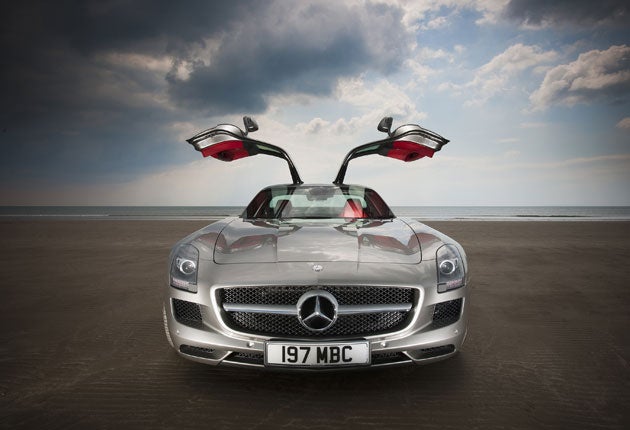Mercedes-Benz SLS AMG
It's 'back to the future' as this new coupé revives the thrills and skills of Fifties-style driving

The car you see here is a Mercedes-Benz SLS AMG, a model first seen two years ago. So why am I telling you about it only now? Two reasons.
Just recently I was able to try it to its considerable limits on the Goodwood motor circuit, which gave a more complete picture of its capabilities than my earlier, and brief, road drive in Wales. And last week I drove its 56-year-old inspiration, loved it and wanted an excuse to tell you about it.
So my head is full of very fast Mercedes-Benz coupés with gullwing doors. We've reached the stage in the march of civilisation, knowledge and technological maturity that progress is no longer inevitable, or even desirable. In some ways we have reached a plateau: the speed of our motor cars, for example. Once there was the urge to make cars ever faster, but now there is a limit (and I don't mean a legal speed limit) beyond which it is pointless to go because we have nowhere to use extra speed.
It was also once a given that new cars should always be quieter, smoother, and more comfortable than the previous ones, with more gadgets and more automation. But here, again, we have reached the limit, beyond which we are left with nothing to do, nothing to stimulate us, and the possibility that the driver no longer controls the car. And while some of us might think we want that, in reality we don't.
This is why Mercedes-Benz has brought us the SLS. As car-lovers look wistfully in the rearview mirror at vehicles which had a personality, made a proper noise, took some skill to drive, and gave huge sensory rewards in return, Mercedes offers a car built with a nod to those values but incorporating modern standards of safety and cleanliness.
The 300SL "Gullwing", made from 1954 to 1957, was startling in several ways. The upward-opening doors, obviously. The pace, reputed to exceed 160mph with the right gear ratios, made the 300SL the first "supercar". The direct fuel injection, unique at the time. And a reputation for extreme trickiness if the driver decelerated or braked in a fast corner, a treachery no modern carmaker could allow. Over the years, the mystique of the Gullwing has loomed large in motoring lore, and today the surviving examples are extremely valuable.
This is the car whose image was pinned on the SLS creators' walls. The SLS, however, is not the first ultra-rapid Benz to tempt the rich and nod to the past. Back in 2003, Mercedes teamed with McLaren to create the SLR, named after a racing sports car most famous for its win in the 1955 Mille Miglia in the hands of Stirling Moss. The supercharged SLR was extremely fast but, despite being made from carbonfibre, was heavy. It also had numb steering, cheap fittings and far too high a price tag – and was overall a disappointment. The SLS is, in a way, Mercedes-Benz making amends and getting it right.
So the SLS, with obvious design references to the 300SL, has an aluminium body, a normally-aspirated 6.2-litre V8 engine of 571bhp and a price which, while high at £168,395, is credible and about the same as an Aston Martin DBS. And it's a proper, high-thrills, old-school, unreconstructed, hot-rod sports GT whose engine bellows like an American stock-car racer's and whose tail-end is ever ready to take part in a powerslide should the mood take you. Unlike its 1950s inspiration, though, the tail doesn't have a mind of its own.
On the road, the SLS looks retro-magnificent with a modern twist, especially in one of the semi-matt finishes. Its steering is quick and super-sharp, the whole car feels writhingly alive and ready to eat up the next piece of road. Just two things cloud the picture. The gearbox's manual paddleshift mode (it's fundamentally an automatic, but it uses clutches instead of the usual torque converter) can be frustratingly slow to respond. And at over two metres wide including mirrors, it's just too broad.
There are times when the rear suspension seems too softly damped, too, causing the tail to bounce and heave on undulating roads. On the track, however, these snags recede. Here the SLS can let rip with monstrous rapidity. It's good, raw fun and, crucially, you're right at the centre of it.
You sense the SLS would make a good racing car, and there is indeed a competition version. An all-electric SLS has been shown, and a roadster is imminent. The aforementioned reservations apart, it's a great car. But the best part is that Mercedes-Benz saw fit to build it.
The making of a legend
In 1952, Mercedes engineering chief Rudolf Uhlenhaut created a lightweight racing coupé with a chassis made of slender steel tubes and an engine borrowed from the 300 saloon. The resulting 300SL sparkled in competition, gaining wins at Le Mans among others. The tubes that made up the deep side sills forced the adoption of gullwing doors. US Mercedes importer Max Hoffman thought the company could sell roadgoing versions, and backed his hunch with an order for 1,000 cars. The road car was actually faster than the racing car because it used direct fuel injection devised for aircraft engines. Today, a good example of a "Gullwing" can go for about £500,000.
Join our commenting forum
Join thought-provoking conversations, follow other Independent readers and see their replies
Comments
Bookmark popover
Removed from bookmarks